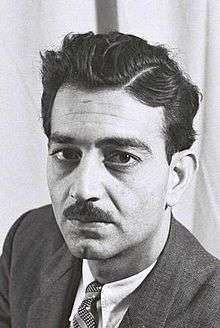Al-Ittihad (Israeli newspaper)
 | |
 | |
| Type | Daily |
|---|---|
| Owner(s) | Maki |
| Editor | Aida Touma-Suleiman |
| Founded | 1944 |
| Language | Arabic |
| Headquarters | Haifa, Israel |
| Country | Israel |
| Website |
www.aljabha.org (Hadash website) |
Al-Ittihad (Arabic: الاتحاد, lit. The Union) is an Israeli Arabic-language daily newspaper based in Haifa and established in 1944 during Mandatory Palestine. The newspaper is the oldest Arab media outlet in Israel and is considered the most important,[1] it is owned by Maki, the Israeli Communist Party. It is currently edited by Aida Touma-Suleiman.
History

The paper was established in 1944 by Emile Toma, Fu'ad Nassar and Emile Habibi.[1] Its first edition was published on 14 May that year. Habibi edited the paper until 1989.[1][2] The newspaper functioned as an organ for the National Liberation League in Palestine.[3] From September 1945 onwards it was published in the name of the Arab Workers' Congress.[4] The newspaper was shut down by the British authorities in February 1948, reappearing on 18 October. In July members of the NLL in Haifa contacted the Mapam party, asking them to pressure Israeli authorities to give a license to resume publishing the newspaper.[5] Al-Ittihad was the only pre-state Arabic-language paper to continue being published after independence.[6] In 1948 it moved into a new building on Al-Hariri Road. In the years after independence when Israeli Arabs were subject to military government, the paper was banned in some areas.[7] It was later banned in the West Bank.[8]
In 1953 Al-Ittihad and its Hebrew sister newspaper, Kol HaAm, published a controversial article on the Korean War, which resulted in the Minister of Internal Affairs, Israel Rokach, ordering both papers to close for 15 days. The papers filed a petition to the Supreme Court, which ruled that the suspension had been wrongly issued and should be set aside.[9] The ruling utilised the Declaration of Independence in making its judgment on the issue of free speech, the first time the declaration had been used as an instrument for interpretation.[9]
While other communist newspapers lost much of their readership after the 1956 war, Al-Ittihad was able to recover, regaining its pre-war readership level by 1961. In 1961, the readership of its Friday edition was twice as large as the readership of Kol HaAm, in spite of the fact that Arabs made up only 11.3% of the country's population, and literacy levels were generally lower in the Arab community. The paper's readership continued to grow gradually for some time.[10] Initially a weekly paper, it was later published biweekly, finally becoming a daily newspaper in 1983.[1]
In 1988 the government again ordered it closed for a week, six days before Land Day.[11][12][13]
Due to financial problems, the newspaper moved to Hadash party headquarters, Beit HaYedidut, in Nazareth, and then returned to Haifa to a building on HaMaronitim Road.[1] In 2006 staff were preparing to return to its Al-Hariri Road location,[1] but the building was hit by a rocket during the 2006 Lebanon War and badly damaged.[14]
Haaretz reports that the paper lost most of its senior reporters in recent years, and that most of these former employees see it as having discarded its earlier pluralism for the Maki party line.[1]
Staff
Editors
Writers
References
- 1 2 3 4 5 6 7 "The rocket hit the struggle for peace" Haaretz, 8 August 2006.
- ↑ Palestinian Writers in Israel Boston Review.
- ↑ Yossi Schwartz. (16 June 2003). Arab-Jewish workers' joint struggles prior to the partition of Palestine - Part Two In Defense of Marxism. Retrieved 13 August 2014.
- ↑ Beinin, Joel. Was the Red Flag Flying There?: Marxist Politics and the Arab-Israeli Conflict in Egypt and Israel, 1948-1965. Berkeley: University of California Press, 1990. pp. 42-43.
- ↑ Beinin, Joel. Was the Red Flag Flying There?: Marxist Politics and the Arab-Israeli Conflict in Egypt and Israel, 1948-1965. Berkeley: University of California Press, 1990. pp. 48, 50, 52.
- ↑ "Arab Soccer in a Jewish State: The Integrative Enclave - Tamir Sorek". Google Books. 21 June 2007. Retrieved 13 August 2014.
- ↑ "The Palestinian-Arab Minority in Israel, 1948-2000: A Political Study - Asʻad Ganim". Google Books. 24 May 2001. Retrieved 13 August 2014.
- ↑ "Israel Yearbook on Human Rights 1980". Google Books. Retrieved 13 August 2014.
- 1 2 Schmidt, Y (2008) Foundations of Civil and Political Rights in Israel and the Occupied Territories GRIN Verlag, p. 126.
- ↑ Beinin, Joel. Was the Red Flag Flying There?: Marxist Politics and the Arab-Israeli Conflict in Egypt and Israel, 1948-1965. Berkeley: University of California Press, 1990. p. 241.
- ↑ "The Arabs in Israel - Ori Stendel". Google Books. 1 January 1997. Retrieved 13 August 2014.
- ↑ https://web.archive.org/web/20121114031824/https://books.google.com/books?id=KYPVNdzXUJkC. Archived from the original on 14 November 2012. Retrieved 20 May 2009. Missing or empty
|title=(help) - ↑ Dan Fisher (25 March 1988). "Most instigators of Israel unrest believed jailed". St. Petersburg Times. p. 18a.
In another action, which was seen as a sign of official concern over protests called for next week, Prime Minister Yitzhak Shamir ordered Al Ittihad, the Arabic-language newspaper of the Israeli Communist Party, closed for a week.... Such closures are relatively common on the West Bank, but Thursday's order against Al Ittihad was believed to be only the second since 1954 involving an Israeli publication. Israel Radio said that Shamir, in his capacity as acting interior minister, issued the order after the newspaper published articles considered likely to encourage activity endangering public safety. This referred to the Communist Party's support of a proposed general strike next week by Israel's 700,000 Arab citizens. The strike would be a show of solidarity with restive Palestinians in the West Bank and Gaza Strip.
- 1 2 Haifa: Rocket hits anti-war newspaper Yedioth Ahronoth, 7 August 2006.
External links
- Al-Ittihad (Arabic)